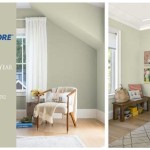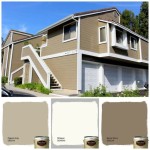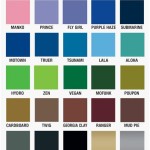Can You Use Dark Paint In Small Rooms?
The question of whether dark paint can be used effectively in small rooms is a long-standing debate in interior design. Conventional wisdom often dictates that light colors are the best choice for small spaces, as they tend to reflect light and create an illusion of spaciousness. However, the application of dark paint within smaller rooms isn't necessarily a design faux pas. In fact, strategic use of dark hues can create dramatic, cozy, and sophisticated environments, defying expectations and challenging traditional design norms. This article will explore the considerations, advantages, and techniques involved in successfully incorporating dark paint into small rooms.
One of the main concerns regarding dark paint in small rooms is its potential to make the space feel smaller and more confined. Dark colors absorb light rather than reflect it, which can indeed lead to a reduction in perceived space. However, the impact of dark paint extends beyond simply diminishing a room's visual volume. The psychological effects of color, the interplay of light and shadow, and the strategic use of contrasting elements all contribute to the overall aesthetic and perceived size of the space.
The success of using dark paint in a small room hinges on careful planning and execution. Before committing to a particular shade, it's crucial to assess the existing lighting conditions, architectural features, and desired atmosphere. Understanding these factors will allow for informed decisions regarding color selection, placement, and complementary design elements.
Understanding the Perception of Space and Color
The human perception of space is heavily influenced by visual cues such as light, color, and depth. Light colors tend to recede, creating the illusion of distance, while dark colors tend to advance, making surfaces appear closer. This inherent property of color forms the basis for the common belief that light colors are preferable for small spaces. However, understanding the nuances of color perception allows for a more nuanced approach to design.
Dark colors, while absorbing light, can also create a sense of depth and drama. When used effectively, they can blur the boundaries of a room, making it difficult to perceive the exact dimensions. This effect can be particularly useful in rooms with awkward shapes or limited natural light. By strategically layering light and shadow, dark paint can create an atmosphere of mystery and intrigue, drawing attention away from the room's small size.
Furthermore, the specific shade of dark paint chosen can significantly impact the overall effect. Dark blues and greens, for example, tend to be more calming and restful than dark reds or browns. The undertones of the paint, whether warm or cool, also play a role in shaping the room's ambiance. A dark paint with warm undertones can create a cozy and inviting atmosphere, while a dark paint with cool undertones can lend a sense of sophistication and elegance.
Successfully integrating dark paint into a small room requires careful consideration of the existing light sources. If the room lacks natural light, it's crucial to supplement it with artificial lighting. Layering different types of lighting, such as ambient, task, and accent lighting, can help to create a balanced and visually appealing environment. Mirrors can also be strategically placed to reflect light and create the illusion of more space.
Techniques for Maximizing the Impact of Dark Paint
Several techniques can be employed to maximize the impact of dark paint in small rooms, mitigating the potential for it to make the space feel confined. One approach is to use dark paint on only one or two walls, creating a focal point and adding visual interest. This technique works particularly well in rooms with architectural features such as fireplaces or large windows. By painting these features in a dark color, you can draw attention to them and create a sense of depth.
Another technique is to pair dark walls with light-colored trim and ceilings. This contrast helps to define the boundaries of the room and prevent it from feeling too enclosed. The light-colored ceiling also reflects more light, further enhancing the sense of spaciousness. Choosing a crisp white or a soft cream for the trim and ceiling can create a sophisticated and timeless look.
Monochromatic color schemes can also be highly effective in small rooms with dark paint. By using different shades of the same color, you can create a sense of depth and visual interest without overwhelming the space. For example, a dark blue wall could be paired with lighter blue accents and accessories. This approach creates a cohesive and harmonious look that is both stylish and sophisticated.
Accenting with metallics can also be a successful strategy. Gold, silver, or bronze elements can reflect light and add a touch of glamour to a dark room. These metallic accents can be introduced through light fixtures, furniture, or decorative accessories. The shimmering effect of metallics can help to break up the monotony of the dark color and add visual interest to the space.
Furnishing choices also play an important role in the overall success of a dark room design. Lighter-colored furniture and accessories can help to balance the darkness of the walls and prevent the room from feeling too heavy. Consider incorporating furniture with clean lines and simple silhouettes to avoid cluttering the space. Adding soft textures, such as plush rugs or velvet cushions, can create a cozy and inviting atmosphere.
Considering Room Use and Personal Style
The intended use of the room should also influence the decision to use dark paint. Dark colors can be particularly effective in bedrooms, creating a relaxing and calming atmosphere conducive to sleep. They can also work well in home offices, providing a sense of focus and concentration. However, dark colors may not be the best choice for areas that require bright, natural light, such as kitchens or bathrooms.
Ultimately, the decision to use dark paint in a small room is a matter of personal preference. While some people may find dark colors claustrophobic, others may find them comforting and stylish. It's important to consider your own aesthetic sensibilities and lifestyle when making this decision. Experimenting with paint samples and creating mood boards can help you visualize the final result and determine whether dark paint is the right choice for your space.
The size and shape of the room must also be considered. In a room with high ceilings, dark paint can visually lower the ceiling, creating a more intimate atmosphere. In a room with low ceilings, however, dark paint may make the ceiling feel even lower. The shape of the room can also influence the placement of dark paint. In a long, narrow room, painting one or both of the end walls in a dark color can help to make the room feel more balanced.
Dark paint can also serve to highlight architectural details. If a room has interesting moldings, trim, or other architectural features, dark paint can draw attention to them. The contrast between the dark walls and the lighter-colored details can create a striking visual effect. Conversely, dark paint can also be used to conceal imperfections in a room's walls or ceiling. The dark color helps to camouflage blemishes and create a more uniform appearance.
Finally, it's important to remember that paint is not a permanent commitment. If you're not happy with the results, you can always repaint the room. Don't be afraid to experiment and try new things. The key to successful interior design is to create a space that reflects your personal style and meets your individual needs. By understanding the principles of color theory and applying them thoughtfully, you can create a beautiful and functional space, regardless of its size.
How To Make Dark Walls In A Small Space Work Woodiwiss Painting
5 Of Best Dark Colors To Paint Small Rooms As Chosen By Designers Livingetc
Surprise You Can Use Dark Colours In A Small Space Here S How
Should Small Rooms Be Painted In Light Or Dark Colors
Why Dark Paint Color Can Make Your Small Room Feel Bigger Michael Helwig Interiors
How Do I Use Dark Paint Colours In A Small Apartment
How To Decorate With Dark Paint In Small Spaces
Why Dark Paint Color Can Make Your Small Room Feel Bigger Michael Helwig Interiors
Surprise You Can Use Dark Colours In A Small Space Here S How
Dark Paint In Small Spaces Rustic Marine
Related Posts








